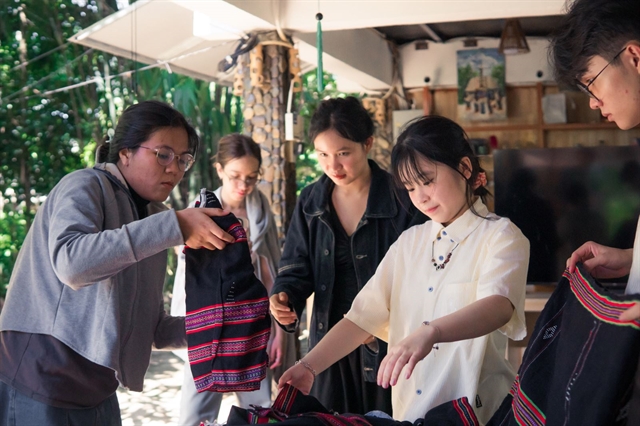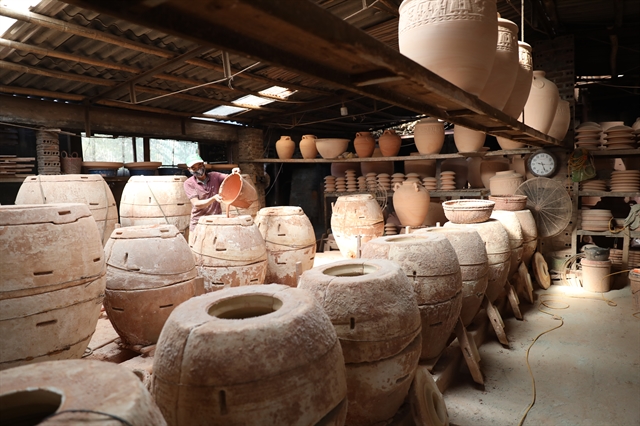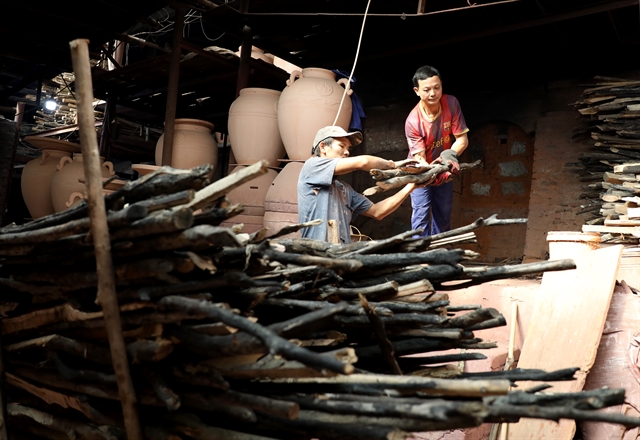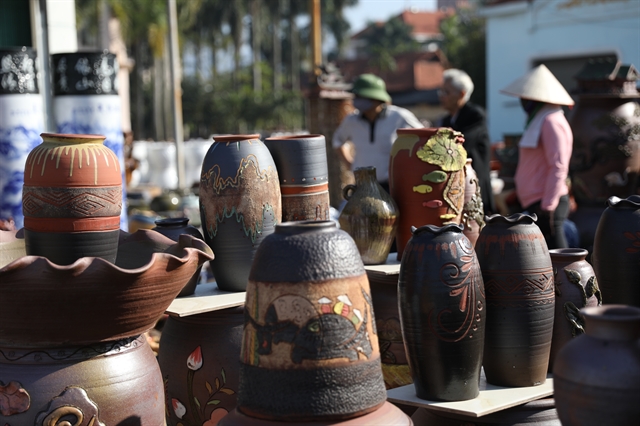 Features
Features

Vĩnh Hồng is currently the only ancient pottery village in the northern province of Quảng Ninh with unique and good quality ceramic products.

|
| A worker is moulding the clay for large vases in Vĩnh Hồng pottery village. VNS Photo Đoàn Tùng |
By Thanh Nga
Vĩnh Hồng is currently the only ancient pottery village in the northern province of Quảng Ninh with unique and good quality ceramic products.
Visiting Vĩnh Hồng in Đông Triều Town on an early winter day, and the road to the village smells of terracotta from the burning kilns. Piles of clay are covered with canvas on the side of the road. In the yards of local houses, porcelain dishes, terracotta vases and pots for sale are widely displayed.
Elderly people say that the village's pottery industry dates back to the 18th century, following the skilled craftmen from Gia Lâm District in Hà Nội who immigrated here.
Although it doesn’t have a rich history like the famous pottery villages such as Bát Tràng in Hà Nội, Hương Canh in Vĩnh Phúc, or Chu Đậu in Hải Dương, Vĩnh Hồng potteries have beautiful designs and high durability.
The traditional pottery village still retains its method of firing its kilns with wood.
“When heat with firewood, the goods are very durable because the kiln is always kept at a stable temperature. Moreover, the cost is much cheaper than a gas kiln. The gas kiln can’t heat many big pieces, but wood-burning kilns can make multiple large products at reasonable prices,” said Trần Duy Hưng, owner of a traditional pottery establishment in Vĩnh Hồng.
“The potteries here are all fired for 24 hours with temperatures ranging from 1,200 to 1,300 degrees Celsius, while many other traditional pottery villages in the north fired their products at only 800 degrees Celsius. So Vĩnh Hồng’s products are durable, thick and the pattern won’t fade because they are carved directly into the product, not painted on the glaze,” Hưng added.
Pottery is Hưng's family’s traditional craft. His kiln has operated for more than 20 years, creating regular jobs for more than 10 workers with an average income of about VNĐ7-8 million (US$300-350) per person a month.
According to Nguyễn Văn Hoàng, who has worked for Hưng for more than 20 years, in order to make a good piece of pottery, the most important steps are choosing good clay and making good moulds. If the mould is not well made, the clay object could be distorted, or the coating liquid is not suitable the product put into the kiln can crack immediately.
Artisan Nguyễn Đình Cầu also said that casting was a very important step. "If you want a beautiful product, you must first have a good mould and beautiful design."
Previously, the whole village of Vĩnh Hồng made potteries, but for a long time the village fell into a state of stagnation due to a lack of new, well-designed products. Some households switched to other jobs, and now there are only 17 households keeping the craft.

|
| Vĩnh Hồng pottery village still retains its method of firing kilns with wood. VNS Photo Đoàn Tùng |
Phạm Văn Thắng, secretary of Vĩnh Hồng Ceramics Branch and director of Thắng Lan Co, said that the village had turned to producing large vases to store wine and fish sauce, and bonsai pots.
This brings the average profit per household from VNĐ20 million to VNĐ30 million per month and creates a stable income of VNĐ7-8 million per month for hundreds of employees.
“We also had exchanges to gain experiences, from production methods as well as consumption plans of pottery and to learn from each other. I myself also learned good ideas from surrounding households and the households also learned from my experiences in making pottery. Therefore, in the past time, in the context of the COVID-19 pandemic, we have also maintained to stabilise production and consumption," said Thắng.
Vĩnh Hồng is a long-standing pottery village, bringing stable income and improving people's lives. This is also the profession that Thắng has been attached to and passionate about for decades.
In order to "keep the fire" of the craft village, Thắng has organised many free vocational training classes for local people, especially for children in difficult circumstances. More than 100 people have been trained and began their careers with Thắng sharing his love and experience of pottery.

|
| Taking out terracotta vases from the kiln. VNS Photo Đoàn Tùng |
Products made from Vĩnh Hồng Village not only meet domestic demand but are also exported to foreign countries. In addition, the production households here have also co-operated with many ceramic producers in surrounding localities to establish the Đông Triều Ceramics Association, helping each other develop production and marketing.
In the near future, a pottery production area of 20 hectares is planned, and Vĩnh Hồng Village will have good conditions to form a model combining production and tourism.
"For Đông Triều pottery, we have determined that this is a relatively typical profession, which requires conservation and promotion measures," Lê Văn Tình, deputy head of Economic Department of Đông Triều Town’s People's Committee, said.
"First, we approved the establishment of the Đông Triều Ceramics Association and built the collective brand of Đông Triều ceramics. Second, we co-operated with the provincial science and technology authority to form a ceramic centre in the area; supporting and creating conditions for businesses and production households to bring their products to participate in trade promotion programmes.” VNS

|
| Many pottery products are sold at the entrance of Vĩnh Hồng Village. VNS Photo Đoàn Tùng |




